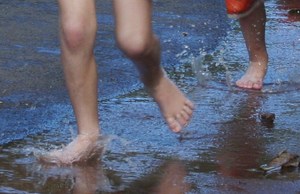Perhaps you have a child who is experiencing sensory issues or a teacher noticing a student or two out-of-sync. Sensory Processing Disorder (SPD) is a disability that needs more recognition. With proper therapy, children will learn and cope with daily sensory struggles.
As described by my child’s occupational therapist, everyone has a sensory system. We all have likes and dislikes. Problems can arise when a child strongly dislikes touch, sound, sight, and/or smell. In some cases these strongly disliked sensations prevent children from interacting, learning and experiencing the world within their senses. Their learning and world becomes limited.
According to the book, The Out-of-Sync Child written by Carol Stock Kranowitz M.A., SPD (Sensory Processing Disorder) can cause a bewildering variety of symptoms. When their central nervous systems are ineffective in processing sensory information, children have a hard time functioning in daily life. They may look fine and have superior intelligence, but may be awkward and clumsy, fearful and withdrawn, or hostile and aggressive. SPD can affect not only how they move and learn, but also how they behave, how they play and make friends, and especially how they feel about themselves.
Sensory Processing Disorder is an updated terminology slowly, but steadily taking over the term Sensory Integration Dysfunction (SID). Sensory Processing Disorder encompasses three main categories. These are Sensory Modulation Disorder, Sensory Discrimination Disorder, Sensory-Based Motor Disorder and their subtypes. The subtypes are Sensory Over-responsivity, Sensory Under-responsivity, Sensory Seeking, Postural Disorder and Dyspraxia.
You may become aware that your child is experiencing a sensory issue problem if you notice the following symptoms.
-Child likes to crash into walls and furniture.
-Child frequently puts non-food items in mouth. Such as shirt collars, toys, hands and other items.
-Child over stuffs mouth while eating.
-Child is afraid of water, sand, vacuums, loud noise and new experiences.
-Child is a picky eater.
-Child doesn’t like to touch certain items. The child may even gag at the sight, sound, smell or touch of these items
-Child doesn’t like light touch, but likes firm touch, bear hugs and firm massage.
-Child doesn’t like firm touch, but prefers light touch, soft pats on the back and soft massage.
-Child avoids interaction with people, such as peers.
The cause of Sensory Processing Disorder remains unknown. Many child development professionals believe that early traumatic experiences can play a role in SPD. Often children with SPD have had traumatic birth experiences and/or hospitalizations. Having a child that had both a traumatic birth experience and early traumatic hospitalization, I can understand this theory. For after his early hospitalization we noticed he stopped rolling over along with other concerning behaviors that later required therapy.
Unfortunately children with Sensory Processing Disorder are often looked upon as unruly, uncooperative and undisciplined. Parents are often left feeling though their child’s reactions are due to a lack of their parenting skills. The truth is these children with SPD are often pained within the world they live in. They cannot help feeling the fight-or-flight response when their sensory issues are triggered.
The good news is that children with Sensory Processing Disorder can be helped. Early Intervention services provide care through occupational therapy and any other services the children qualify for. Seeking help early for children with SPD proves to have lasting results. Children can learn to cope and even enjoy a new life through their senses.
Many child development professionals are unaware of Sensory Processing Disorder. Children are often misdiagnosed of having ADHD or a form of Autism. If you notice that your child might be struggling with any of the above symptoms contact your local Heath Department for Early Intervention services.
It’s my hope to get Sensory Processing Disorder known by more parents, educators and health professionals. With better understanding of SPD, we can help children get a proper diagnosis, therapy and outcome.
For futher information on Sensory Processing Disorder read the following article.
Gifts for Children with Sensory Processing Disorder
Source
The Out-of-Sync Child
Reference:
- The Out-of-Sync Child




